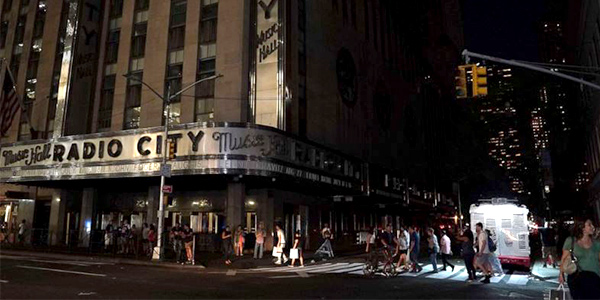By Rich Heidorn Jr.
Consolidated Edison blamed a failed relay protection system for the blackout that darkened Broadway stages and left Manhattan residents without air conditioning, subways or elevators for up to five hours Saturday. About 72,000 customers were affected between West 30th and West 72nd streets, and from the Hudson River to Fifth Avenue.
The outage, which came on the 42nd anniversary of the city’s 1977 blackout, forced the cancellation of most Broadway shows, leading to impromptu performances outside theaters by cast members. Civilians took to the streets to direct traffic.
New York officials said about 2,800 stranded commuters had to be rescued from subways and hundreds more from more than 400 frozen elevators. Fans of singer Jennifer Lopez were evacuated from Madison Square Garden shortly her sold-out concert began. Temperatures were in the low 80s, with typical New York summer humidity.
The company said it restored power within five hours and that more than half the affected customers got power in less than three hours.
Source Identified
Con Ed said it had traced the outage to the failure of a relay protection system at its West 65th Street substation, which is designed to detect faults and cause circuit breakers to isolate and de-energize the faults.
“The relay protection system is designed with redundancies to provide high levels of reliability. In this case, primary and backup relay systems did not isolate a faulted 13,000-volt distribution cable at West 64th Street and West End Avenue,” Con Ed said in a statement. “The failure of the protective relay systems ultimately resulted in isolation of the fault at the West 49th Street transmission substation, and the subsequent loss of several electrical networks, starting at 6:47 p.m.”
The company had initially said the 13-kV cable fault was unrelated to the outage. “While the cable fault was an initiating event, the customer outages were the result of the failure of the protective relay systems,” it said.
Consolidated Edison Company of New York (CECONY) President Timothy Cawley told The New York Times that at least two parts of the utility’s system failed to operate properly and prevent cascading to six neighborhood networks. He said he had never “experienced a case like this.”
Although it could take weeks before the company completes its investigation of the outage, he insisted he was “very confident” there would be no repeat.
But he said investigators had determined that the protective relay system there failed to operate as designed on two levels and those failures triggered the halt of the flow of electricity.
Reaction
The incident prompted howls of outrage.
The New York Post used the incident to call for the ouster of Mayor Bill de Blasio, a 2020 presidential candidate who was campaigning in Iowa when the lights went out.
U.S. Sen. Chuck Schumer (D-N.Y.) tweeted that the Department of Energy should investigate the outage with state and city officials. “This type of massive blackout is entirely preventable with the right investments in our grid,” he said.
Gov. Andrew Cuomo warned in interviews that Con Ed “does not have a franchise granted by God” and “can be replaced.”
“We got very lucky the other night. When you have a blackout in a city like New York, you are one step away from chaos and mayhem,” Cuomo said in a television interview. The 1977 blackout, which lasted more than a day, led to looting and arson that caused millions in damage. About 3,800 people were arrested.
Cuomo said the incident was just the latest in a series of failures, citing the outage following a fire in a Queens substation in December, a September 2017 power failure at a Brooklyn substation and an April 2017 subway outage blamed on the failure of Con Ed’s electric supply.
On Tuesday night, about 2,100 Con Ed customers lost power for up to seven hours after a fire at a substation on Staten Island.
Con Ed spokesman Michael Clendenin responded in a televised interview that the company’s system “is probably better than any other” in the U.S.
PA Consulting Group last year selected Con Ed as the Northeast region national winner of its ReliabilityOne Award for its 2017 performance.
In January, CECONY, which serves New York City and Westchester County, asked the state Public Service Commission for a $485 million (8.6%) rate increase. Its sister company, Orange and Rockland Utilities, was among four companies penalized by state regulators last month for poor service. (See NY Utilities Dinged for 2018 Reliability, Safety.)
The fact that the incident occurred on the anniversary of the 1977 blackout led some — including “The Daily Show” host Trevor Noah — to speculate without evidence that sabotage might have been the cause.
NERC spokeswoman Kimberly Mielcarek rejected that idea.
“A root cause analysis of the outage is underway, but at this time, there is no evidence of suspicious activity or long-term impacts to infrastructure,” she said. “The bulk power system remained stable and unaffected by the outage.”
FERC spokeswoman Mary O’Driscoll said the commission “will be closely monitoring NERC’s steps in responding to this event.” New York PSC spokesman James Denn said state officials were investigating, “as directed by Gov. Cuomo.”
Although Con Ed officials said summer air conditioning loads were unrelated to the outage, they were making no promises about the system’s ability to withstand the coming weekend’s heat, when temperatures are expected to reach the upper 90s.
“We expect that there could be service outages,” Clendenin said. “Those things happen during heat waves.”






